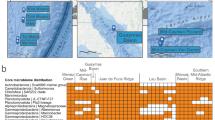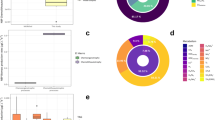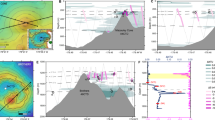Abstract
Within hydrothermal plumes, chemosynthetic processes and microbe–mineral interactions drive primary productivity in deep-ocean food webs and may influence transport of elements such as iron. However, the source of microorganisms in plumes and the factors governing how these communities assemble are poorly understood, in part due to lack of data from early stages of plume formation. In this study, we examined microbial community composition of rising hydrothermal plumes from five vent fields along the Eastern Lau Spreading Center. Seafloor and plume microbial communities were significantly dissimilar and shared few phylotypes. Plume communities were highly similar to each other with significant differences in community membership only between Kilo Moana and Mariner, two vents that are separated by extremes in depth, latitude and geochemistry. Systematic sampling of waters surrounding the vents revealed that species richness and phylogenetic diversity was typically highest near the vent orifice, implying mixing of microbial communities from the surrounding habitats. Above-plume background communities were primarily dominated by SAR11, SAR324 and MG-I Archaea, while SUP05, Sulfurovum, Sulfurimonas, SAR324 and Alteromonas were abundant in plume and near-bottom background communities. These results show that the ubiquitous water-column microorganisms populate plume communities, and that the composition of background seawater exerts primary influence on plume community composition, with secondary influence from geochemical and/or physical properties of vents. Many of these pervasive deep-ocean organisms are capable of lithotrophy, suggesting that they are poised to use inorganic electron donors encountered in hydrothermal plumes.
Similar content being viewed by others
Log in or create a free account to read this content
Gain free access to this article, as well as selected content from this journal and more on nature.com
or
References
Amend JP, McCollom TM, Hentscher M, Bach W . (2011). Catabolic and anabolic energy for chemolithoautotrophs in deep-sea hydrothermal systems hosted in different rock types. Geochim Cosmochim Acta 75: 5736–5748.
Anantharaman K, Breier JA, Sheik CS, Dick GJ . (2013). Evidence for hydrogen oxidation and metabolic plasticity in widespread deep-sea sulfur-oxidizing bacteria. Proc Natl Acad Sci USA 110: 330–335.
Anderson RE, Beltrán MT, Hallam SJ, Baross JA . (2013). Microbial community structure across fluid gradients in the Juan de Fuca Ridge hydrothermal system. FEMS Microbiol Ecol 83: 324–339.
Baker B, Lesniewski R, Dick G . (2012). Genome-enabled transcriptomics reveals archaeal populations that drive nitrification in a deep-sea hydrothermal plume. ISME J 6: 2269–2279.
Baker ET, Massoth GJ, Nakamura K-i, Embley RW, de Ronde CEJ, Arculus RJ . (2005). Hydrothermal activity on near-arc sections of back-arc ridges: results from the Mariana Trough and Lau Basin. Geochem Geophys Geosyst 6: Q09001.
Bates ST, Berg-Lyons D, Caporaso JG, Walters WA, Knight R, Fierer N . (2011). Examining the global distribution of dominant archaeal populations in soil. ISME J 5: 908–917.
Beaulieu SE, Baker ET, German CR, Maffei A . (2013). An authoritative global database for active submarine hydrothermal vent fields. Geochem Geophy Geosy 14: 4892–4905.
Bennett SA, Coleman M, Huber JA, Reddington E, Kinsey JC, McIntyre C et al. (2013). Trophic regions of a hydrothermal plume dispersing away from an ultramafic-hosted vent-system: Von Damm vent-site, Mid-Cayman Rise. Geochem Geophy Geosy 14: 317–327.
Boström K, Peterson MNA . (1969). The origin of aluminum-poor ferromanganoan sediments in areas of high heat flow on the East Pacific Rise. Mar Geol 7: 427–447.
Bourbonnais A, Juniper SK, Butterfield DA, Devol AH, MMM Kuypers, Lavik G et al. (2012). Activity and abundance of denitrifying bacteria in the subsurface biosphere of diffuse hydrothermal vents of the Juan de Fuca Ridge. Biogeosciences 9: 4661–4678.
Bowie AR, Townsend AT, Lannuzel D, Remenyi TA, van der Merwe P . (2010). Modern sampling and analytical methods for the determination of trace elements in marine particulate material using magnetic sector inductively coupled plasma, Äìmass spectrometry. Anal Chim Acta 676: 15–27.
Breier JA, German CR, White SN . (2009a). Mineral phase analysis of deep-sea hydrothermal particulates by a Raman spectroscopy expert algorithm: Toward autonomous in situ experimentation and exploration. Geochem Geophy Geosy 10: Q05T05.
Breier JA, Rauch CG, McCartney K, Toner BM, Fakra SC, White SN et al. (2009b). A suspended-particle rosette multi-sampler for discrete biogeochemical sampling in low-particle-density waters. Deep-Sea Res Pt I 56: 1579–1589.
Breier JA, Toner BM, Fakra SC, Marcus MA, White SN, Thurnherr AM et al. (2012). Sulfur, sulfides, oxides and organic matter aggregated in submarine hydrothermal plumes at 9º50 N East Pacific Rise. Geochim Cosmochim Acta 88: 216–236.
Brown MV, Donachie SP . (2007). Evidence for tropical endemicity in the Deltaproteobacteria Marine Group B/SAR324 bacterioplankton clade. Aquat Microb Ecol 46: 107.
Campbell BJ, Engel AS, Porter ML, Takai K . (2006). The versatile [epsi]-proteobacteria: key players in sulphidic habitats. Nat Rev Microbiol 4: 458–468.
Cowen JP, Massoth GJ, Baker ET . (1986). Bacterial scavenging of Mn and Fe in a mid- to far-field hydrothermal particle plume. Nature 322: 169–171.
de Angelis MA, Lilley MD, Olson EJ, Baross JA . (1993). Methane oxidation in deep-sea hydrothermal plumes of the Endeavor Segment of the Juan de Fuca Ridge. Deep-Sea Res Pt I 40: 1169–1186.
Dick GJ, Clement BG, Webb SM, Fodrie FJ, Bargar JR, Tebo BM . (2009). Enzymatic microbial Mn(II) oxidation and Mn biooxide production in the Guaymas Basin deep-sea hydrothermal plume. Geochim Cosmochim Acta 73: 6517–6530.
Dick GJ, Tebo BM . (2010). Microbial diversity and biogeochemistry of the Guaymas Basin deep-sea hydrothermal plume. Environ Microbiol 12: 1334–1347.
Dick GJ, Anantharaman K, Baker BJ, Li M, Reed DC, Sheik CS . (2013). The microbiology of deep-sea hydrothermal vent plumes: ecological and biogeographic linkages to seafloor and water column habitats. Front Ext Microbiol 4: 1–16.
Edgar RC . (2013). UPARSE: highly accurate OTU sequences from microbial amplicon reads. Nat Methods 10: 996–998.
Elderfield H, Schultz A . (1996). Mid-ocean ridge hydrothermal fluxes and the chemical composition of the ocean. Annu Rev Earth Planet Sci 24: 191–224.
Faith DP, Lozupone CA, Nipperess D, Knight R . (2009). The cladistic basis for the phylogenetic diversity (PD) measure links evolutionary features to environmental gradients and supports broad applications of microbial ecology’s ‘phylogenetic beta diversity’ framework. Int J Mol Sci 10: 4723–4741.
Ferrini VL, Tivey MK, Carbotte SM, Martinez F, Roman C . (2008). Variable morphologic expression of volcanic, tectonic, and hydrothermal processes at six hydrothermal vent fields in the Lau back-arc basin. Geochem Geophys Geosyst 9: Q07022.
Fierer N, Hamady M, Lauber CL, Knight R . (2008). The influence of sex, handedness, and washing on the diversity of hand surface bacteria. Proc Natl Acad Sci USA 105: 17994–17999.
Flores GE, Shakya M, Meneghin J, Yang ZK, Seewald JS, Geoff Wheat C et al. (2012). Inter-field variability in the microbial communities of hydrothermal vent deposits from a back-arc basin. Geobiology 10: 333–346.
Gartman A, Findlay AJ, Luther GW III . (2014). Nanoparticulate pyrite and other nanoparticles are a widespread component of hydrothermal vent black smoker emissions. Chem Geol 366: 32–41.
German C, Bowen A, Coleman M, Honig D, Huber J, Jakuba M et al. (2010). Diverse styles of submarine venting on the ultraslow spreading Mid-Cayman Rise. Proc Natl Acad Sci USA 107: 14020–14025.
German CR, Von Damm KL . (2004) Hydrothemal Processes vol. 6 Elsevier: Oxford, UK.
German CR, Baker ET, Connelly DP, Lupton JE, Resing J, Prien RD et al. (2006). Hydrothermal exploration of the Fonualei Rift and Spreading Center and the Northeast Lau Spreading Center. Geochem Geophys Geosyst 7: Q11022.
Ghiglione J-F, Galand P, Pommier T, Pedrós-Alió C, Maas E, Bakker K et al. (2012). Pole-to-pole biogeography of surface and deep marine bacterial communities. Proc Natl Acad Sci USA 109: 17633–17638.
Holden J, Breier J, Rogers K, Schulte M, Toner B . (2012). Biogeochemical processes at hydrothermal vents: microbes and minerals, bioenergetics, and carbon fluxes. Oceanography 25: 196–208.
Hsu-Kim H, Mullaugh K, Tsang J, Yucel M, Luther G . (2008). Formation of Zn- and Fe-sulfides near hydrothermal vents at the Eastern Lau Spreading Center: implications for sulfide bioavailability to chemoautotrophs. Geochem T 9: 6.
Huber JA, Butterfield DA, Baross JA . (2003). Bacterial diversity in a subseafloor habitat following a deep-sea volcanic eruption. FEMS Microbiol Ecol 1475: 1–17.
Huber JA, Mark Welch D, Morrison HG, Huse SM, Neal PR, Butterfield DA . (2007). Microbial population structures in the deep marine biosphere. Science 318: 97–100.
Jannasch HW, Wirsen CO . (1979). Chemosynthetic Primary Production at East Pacific Sea Floor Spreading Centers. BioScience 29: 592–598.
Jannasch HW, Mottl MJ . (1985). Geomicrobiology of deep-sea hydrothermal vents. Science 229: 717–725.
Jiang H, Breier JA . (2014). Physical controls on mixing and transport within rising submarine hydrothermal plumes: a numerical similation study. Deep-Sea Res Pt I 92: 41–55.
Kadko D . (1993). An assessment of the effect of chemical scavenging within submarine hydrothermal plumes upon ocean geochemistry. Earth Planet Sci Lett 120: 361–374.
Kamenetsky VS, Crawford AJ, Eggins S, Mühe R . (1997). Phenocryst and melt inclusion chemistry of near-axis seamounts, Valu Fa Ridge, Lau Basin: insight into mantle wedge melting and the addition of subduction components. Earth Planet Sci Lett 151: 205–223.
Karl DM, Wirsen CO, Jannasch HW . (1980). Deep-sea primary production at the Galapagos hydrothermal vents. Science 207: 1345–1347.
Karner MB, DeLong EF, Karl DM . (2001). Archaeal dominance in the mesopelagic zone of the Pacific Ocean. Nature 409: 507–510.
Kembel SW . (2009). Disentangling niche and neutral influences on community assembly: assessing the performance of community phylogenetic structure tests. Ecol Lett 12: 949–960.
Kembel SW, Cowan PD, Helmus MR, Cornwell WK, Morlon H, Ackerly DD et al. (2010). Picante: R tools for integrating phylogenies and ecology. Bioinformatics 26: 1463–1464.
Lam P, Cowen JP, Jones RD . (2004). Autotrophic ammonia oxidation in a deep-sea hydrothermal plume. FEMS Microbiol Ecol 47: 191–206.
Lesniewski RA, Jain S, Anantharaman K, Schloss PD, Dick GJ . (2012). The metatranscriptome of a deep-sea hydrothermal plume is dominated by water column methanotrophs and lithotrophs. ISME J 6: 1–11.
Li M, Jain S, Baker BJ, Taylor C, Dick GJ . (2014a). Novel hydrocarbon monooxygenase genes in the metatranscriptome of a natural deep-sea hydrocarbon plume. Environ Microbiol 16: 60–71.
Li M, Toner BM, Baker BJ, Breier JA, Sheik CS, Dick GJ . (2014b). Microbial iron uptake as a mechanism for dispersing iron from deep-sea hydrothermal vents. Nat Commun 5: 3192.
Lupton JE, Delaney JR, Johnson HP, Tivey MK . (1985). Entrainment and vertical transport of deep-ocean water by buoyant hydrothermal plumes. Nature 316: 621–623.
Luther GW, Rozan TF, Taillefert M, Nuzzio DB, Di Meo C, Shank TM et al. (2001). Chemical speciation drives hydrothermal vent ecology. Nature 410: 813–816.
Martinez F, Taylor B . (2002). Mantle wedge control on back-arc crustal accretion. Nature 416: 417–420.
Mattes TE, Nunn BL, Marshall KT, Proskurowski G, Kelley DS, Kawka OE et al. (2013). Sulfur oxidizers dominate carbon fixation at a biogeochemical hot spot in the dark ocean. ISME J 7: 2349–2360.
McCollom TM . (2000). Geochemical constraints on primary productivity in submarine hydrothermal vent plumes. Deep-Sea Res Pt I 47: 85–101.
Morris RM, Rappe MS, Connon SA, Vergin KL, Siebold WA, Carlson CA . (2002). SAR11 clade dominates ocean surface bacterioplankton communities. Nature 420: 806–810.
Mottl MJ, Seewald JS, Wheat CG, Tivey MK, Michael PJ, Proskurowski G et al. (2011). Chemistry of hot springs along the Eastern Lau Spreading Center. Geochim Cosmochim Acta 75: 1013–1038.
Oksanen J, Blanchet FG, Kindt R, Legendre P, Minchin PR, O'Hara RB et al. (2013) vegan: Community Ecology Package R package version.
Petersen JM, Wentrup C, Verna C, Knittel K, Dubilier N . (2012). Origins and evolutionary flexibility of chemosynthetic symbionts from deep-sea animals. Bio Bul 223: 123–137.
Price MN, Dehal PS, Arkin AP . (2009). FastTree: computing large minimum evolution trees with profiles instead of a distance matrix. Mol Biol Evol 26: 1641–1650.
Pruesse E, Quast C, Knittel K, Fuchs BM, Ludwig W, Peplies J et al. (2007). SILVA: a comprehensive online resource for quality checked and aligned ribosomal RNA sequence data compatible with ARB. Nucleic Acids Res 35: 7188–7196.
R Core Team. (2013) R: A Language and Environment for Statistical Computing. R Foundation for Statistical Computing: Vienna, Austria.
Raczek I, Stoll B, Hofmann AW, Peter Jochum K . (2001). High-precision trace element data for the USGS reference materials BCR-1, BCR-2, BHVO-1, BHVO-2, AGV-1, AGV-2, DTS-1, DTS-2, GSP-1 and GSP-2 by ID-TIMS and MIC-SSMS. Geostand Newslett 25: 77–86.
Schloss PD, Westcott SL, Ryabin T, Hall JR, Hartmann M, Hollister EB et al. (2009). Introducing mothur: open-source, platform-independent, community-supported software for describing and comparing microbial communities. Appl Environ Microb 75: 7537–7541.
Sheik CS, Jain S, Dick GJ . (2014). Metabolic flexibility of enigmatic SAR324 revealed through metagenomics and metatranscriptomics. Environ Microbiol 16: 304–317.
Sievert SM, Hügler M, Taylor CD, Wirsen CO . (2008) Sulfur Oxidation at Deep-Sea Hydrothermal Vents vol. 238-258 Springer: New York, NY, USA.
Speer K, Thurnherr AM . (2012). The Lau Basin Float Experiment (LAUB-FLEX). Oceanography 25: 284–285.
Speer KG, Maltrud ME, Thurnherr AM . (2002). A global view of dispersion above the mid-ocean ridge. In: Halbach PE, Tunnicliffe V, Hein JR (eds) Energy and Mass Transfer in Marine Hydrothermal Systems. Dahlem University Press: Berlin, Germany, p 365.
Sunamura M, Higashi Y, Miyako C, Ishibashi J, Maruyama A . (2004). Two Bacteria phylotypes are predominant in the Suiyo Seamount hydrothermal plume. Appl Environ Microb 70: 1190–1198.
Sylvan JB, Pyenson BC, Rouxel O, German CR, Edwards KJ . (2012). Time-series analysis of two hydrothermal plumes at 9°50′N East Pacific Rise reveals distinct, heterogeneous bacterial populations. Geobiology 10: 178–192.
Sylvan JB, Sia TY, Haddad AG, Briscoe LJ, Toner BM, Girguis PR et al. (2013). Low temperature geomicrobiology follows host rock composition along a geochemical gradient in lau basin. FMICB 4: 61.
Tavormina PL, Ussler W, Joye SB, Harrison BK, Orphan VJ . (2010). Distributions of putative aerobic methanotrophs in diverse pelagic marine environments. ISME J 4: 700–710.
Thrash CJ, Temperton B, Swan BK, Landry ZC, Woyke T, DeLong EF et al. (2014). Single-cell enabled comparative genomics of a deep ocean SAR11 bathytype. ISME J.
Tivey M, Becker E, Beinart R, Fisher C, Girguis P, Langmuir C et al. (2012). Links from Mantle to Microbe at the Lau Integrated Study Site: insights from a Back-Arc Spreading Center. Oceanography 25: 62–77.
Toner BM, Fakra SC, Manganini SJ, Santelli CM, Marcus MA, Moffett JW et al. (2009). Preservation of iron(II) by carbon-rich matrices in a hydrothermal plume. Nat Geosci 2: 197–201.
Walsh D, Zaikova E, Howes C, Song Y, Wright J, Tringe S et al. (2009). Metagenome of a versatile chemolithoautotroph from expanding oceanic dead zones. Science 326: 578–582.
Wang Q, Garrity GM, Tiedje JM, Cole JR . (2007). Naïve Bayesian classifier for rapid assignment of rRNA sequences into the new bacterial taxonomy. Appl Environ Microb 73: 5261–5267.
Winn CD, Karl DM, Massoth GJ . (1986). Microorganisms in deep-sea hydrothermal plumes. Nature 320: 744–746.
Wu J, Wells ML, Rember R . (2011). Dissolved iron anomaly in the deep tropical, subtropical Pacific: evidence for long-range transport of hydrothermal iron. Geochim Cosmochim Acta 75: 460–468.
Yucel M, Gartman A, Chan CS, Luther GW . (2011). Hydrothermal vents as a kinetically stable source of iron-sulphide-bearing nanoparticles to the ocean. Nat Geosci 4: 367–371.
Acknowledgements
We thank the Capitan and crew of the R/V Thomas G Thompson as well as the crew of the remotely operated vehicle Jason II. We also thank Drs AL Reysenbach, M Tivey, C Fisher, P Girguis, G Luther and the Eastern Lau Spreading Center 2009 scientific parties for allowing us to participate in their cruises (National Science Foundation Grants: OCE-0424953, OCE-02040985, OCE-0728391, OCE-0752469 and OCE-0751839). We are grateful to Dr AL Reysenbach for providing access to seafloor sequences and Dr Sheri White for assistance with sampling. This work was funded by National Science Foundation Grants (OCE-1038006, OCE-1029242 and OCE-1038055) and the Gordon and Betty Moore Foundation (GBMF 2609). JAB was supported by Grant OCE-1038055, and the Frank and Lisina Hock Endowed fund was provided in support of the Scientific Staff. We gratefully acknowledge the constructive comments of two anonymous reviewers, which greatly improved the manuscript.
Author information
Authors and Affiliations
Corresponding author
Ethics declarations
Competing interests
The authors declare no conflict of interest.
Additional information
Supplementary Information accompanies this paper on The ISME Journal website
Supplementary information
Rights and permissions
About this article
Cite this article
Sheik, C., Anantharaman, K., Breier, J. et al. Spatially resolved sampling reveals dynamic microbial communities in rising hydrothermal plumes across a back-arc basin. ISME J 9, 1434–1445 (2015). https://doi.org/10.1038/ismej.2014.228
Received:
Revised:
Accepted:
Published:
Issue date:
DOI: https://doi.org/10.1038/ismej.2014.228
This article is cited by
-
Submarine volcanic microbiota record three volcano-induced tsunamis
Communications Earth & Environment (2024)
-
Genome-resolved evidence for functionally redundant communities and novel nitrogen fixers in the deyin-1 hydrothermal field, Mid-Atlantic Ridge
Microbiome (2022)
-
Niche differentiation of sulfur-oxidizing bacteria (SUP05) in submarine hydrothermal plumes
The ISME Journal (2022)
-
Biodiversity and degradation potential of oil-degrading bacteria isolated from sediments of hydrothermal and non-hydrothermal areas of the Southwest Mid-Indian Ocean Ridge
Environmental Science and Pollution Research (2022)
-
Hydrothermal plumes as hotspots for deep-ocean heterotrophic microbial biomass production
Nature Communications (2021)



